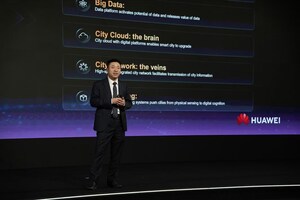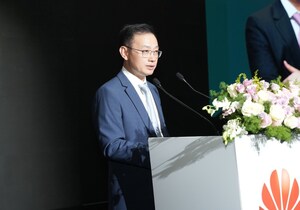Huawei Announces Case Study Demonstrating How Artificial Intelligence Saves Time and Lives
SHANGHAI, Dec. 8, 2020 /PRNewswire/ -- Huawei Technologies, focused on the development of superb computing power and AI capacities, announced its case study of YITU Healthcare's use of the Huawei Atlas series to provide solutions for speedy and precise diagnoses.
In response to the ongoing COVID-19 pandemic, YITU Healthcare, a leading firm in the imaging sector, is providing an Automatic Evaluation System for chest CT scans for the disease. Different from the traditional manual evaluation process that usually takes two to three hours, the automatic system can analyze and classify pneumonia severity within three seconds. It can automatically compare a patient's historical and current records and is highly consistent with doctors' diagnosis.
For lung cancer screening, YITU Healthcare offers the care.ai® Intelligent 4D Imaging System for Chest CT scans. It comes with authoritative evidence-based clinical guidelines, as a vast volume of RWE- based training data. It not only detects lesions but also further suggests its malignancy score and assesses its progression.
A similar system – one that supports multiple standards – is applied for evaluation of children's bone age, where a diagnosis can be made within seconds. It is now commonly used for children's bone age assessment within a condensed timeframe: less than five minutes for X-ray, evaluation and reporting.
Huawei Atlas series represents a powerful AI computing platform
All these solutions require tremendous computing power to provide accurate and timely analysis. This is made possible by Huawei's Atlas series, which supports a wide range of medical scenarios that usually demand huge computing power for the best results.
The Atlas series covers device, edge, to cloud computing settings. The core of the intelligent healthcare solution for YITU is the Atlas 300I AI inference card and Atlas 800 AI inference server. The solution provides the computing power for image and video analysis, shortening CT scan analysis to just two minutes, with an accuracy of over 98 percent. The Atlas 300I card boasts around 33 percent more computing power with double the number of full-HD video channels than some available products in the market.
Meanwhile, the Atlas 800 server comes with two Kunpeng 920 processors, 32 DD4 DIMM slots supporting up to 2,933 MT/s plus as many as eight Atlas 300I cards leading to a maximum of 640 channels for intelligent video analytics. It is a powerful server setting that works best for real-time inference that demands high efficiency with low power consumption. Pairing up with the digital vision pre-processing (DVPP) engine of Atlas 300I, the Atlas 800 server performs remarkably for real-time encoding/decoding and inference of up to 512 video streams.
The innovative use of resources – computing power up to 512 TOPS at INT8 – allows not just much faster diagnosis but also a vast boost in accuracy thanks to the improved recognition precision. It is highly flexible, and performs perfectly well with FlexIO cards and standard iNICs with storage of enormous capacity, which makes the system reliable and secure.
"Healthcare is once again under the spotlight, given the current global situation. Medical science has undoubtedly improved rapidly, extending life expectancy across the globe. Automation is among the most crucial tech breakthroughs in the sector, with Artificial Intelligence (AI) emerging as a powerful tool for medical success," said Tony Xu, President of Huawei Ascend Computing Business.
AI drives growth in medical imaging
There is a common myth in healthcare that many people expect robots to take over from doctors and nurses, rendering people obsolete. Patients might place trust in machines – rather than doctors – to make difficult decisions. However, AI is not replacing doctors. It is instead helping them improve diagnostic accuracy and efficiency. AI does its work by accessing substantial datasets of potentially life-saving information, such as treatment methods and their outcomes, and other data like survival rates, etc.
Therefore, incorporating AI into clinical workflows helps streamline medical procedures for doctors. Medical imaging analysis is one key area that requires an upgrade with the support of AI. Primary medical imaging represents tremendous potential for growth due to its increasing demand. With the help of AI, imaging services get a significant boost in resolving supply and demand discrepancies among current medical services.
In some countries, as many as two-thirds of primary hospitals serve as few as twenty percent of patients requiring diagnosis and treatment, while a small percentage of lower-tier medical institutions is where more than one-third of patients seek medical services. This resource mismatch represents another trend – AI empowers primary medical care, which further alleviates the imbalance between supply and demand of existing medical services. With the increasingly alarming shortage of radiologists in primary medical institutions, this development couldn't have come sooner.
A further observation in medical imaging is the marriage between hardware and software. Simply put, an AI algorithm works with hardware to boost intelligence density and lower the cost of building up the system. The demand for computing, meanwhile, will keep going up to meet the AI requirements for various scenarios in the new digital era. For AI to work effectively, it takes both software and hardware to work together - they go hand in glove.
And so with the power of AI, the application of imaging is brought to another level, where radiologists play more significant roles in the clinical decision-making process. Intelligent diagnosis systems are now used in chest examinations, mammography's, and for pediatric growth and development, allowing radiologists to participate more in giving advice upon receipt of results.
For more information, please visit here.
Email: [email protected]
Photo - https://mma.prnewswire.com/media/1360897/Huawei.jpg







Share this article